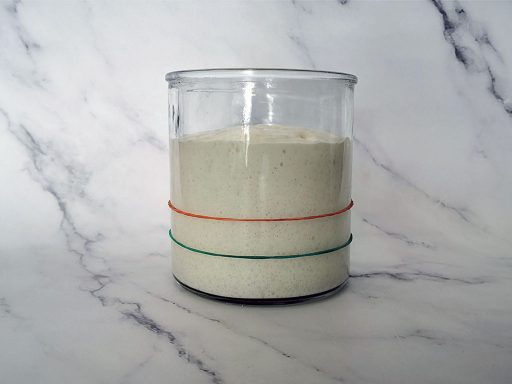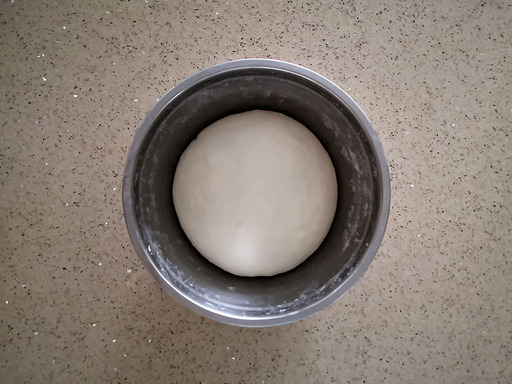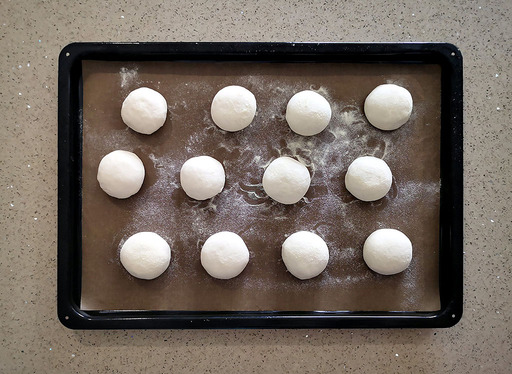A yummlylicious bread with "nook and crannies"

What are English Muffins?
When I first heard about English Muffins, the first thing that popped into my head was that it was made in England and little cake-like muffins that you make and bake. After doing some research, I found out that English Muffins were made in the 1880s by an Englishman, Samuel Bath Thomas who opened a bakery in New York. It was initially called “toasted crumpets”, as it was quite similar to crumpets.
An English Muffins is a round and raised flat bread, which looks like scone from the outside but looks like crumpets on the inside. It is split into two with a fork in order to preserve all the “nook and crannies” made from big pockets of air. From where I am from, you can usually only find the commercially yeasted version of English Muffins in Mcdonald’s and restaurants. It’s not even commonly found in bakeries so I decided to make my own sourdough version of it.
To be honest, I have never made English Muffins before in my life. I was a little apprehensive at first, wondering how it will turn out. And of course, the first batch wasn’t perfect. It was a little overproofed and may be a little burnt. After trying out a few recipes and adjusting the temperature and timings, I have finally nailed it!
So what do I like about this recipe?
- The ease, the taste, the texture with all it’s nooks and crannies.
- Great recipe for those who don’t have an oven as you will only need a pan.
- Easy to freeze and defrost when needed!
What do you need?
Listed below are the baking tools and supplies that you will need to prepare in advance.
- Active Sourdough Starter
- Digital weighing Scale
- Digital Thermometer
- Mixing bowl
- Spatula
- Cast Iron pan or Non-stick pan
To learn more details about baking tools, please visit Baking Tools and Supplies.
How to make English Muffins?
Step 1: Prepare levain and wet mixture
Mix 50g active starter, 50g high protein flour and 50g water. For best results, let the starter rise to peak before using it. Once the starter reaches its peak, use a mixing bowl to mix 145g levain and 240ml water together with a spatula.


Step 2: Mix the dough
Using another bowl, combine all the dry ingredients together. Measure out 400g high protein flour, 40g wholemeal flour, 18g milk powder, 8g salt and 10g sugar and stir it together. Then, pour the dry mixture into the wet mixture and mix it together until no dry flour bits remain. Knead the dough by hand (or a mixer) for 5-7 minutes. Once the dough gluten has formed, it’s time to add 18g butter and continue kneading until it is well incorporated. Check that dough passes the windowpane test.


Step 3: Bulk Fermentation
Next, it is time for you to sit back and let the yeast do the work. Let the dough ferment at room temperature for about 2.5-3 hours or until the dough doubles in size. After fermentation, the dough should be light and elastic.


Step 4: Preshape
Gently deflate the dough before dividing it into 12 portions and shape each into a small boule (round).
Step 5: Final Shape
Let it rest for about 10 minutes or so before flattening each ball into a 8cm (3 inch) round, 1cm (1/2 inch) thick. Coat the dough with semolina flour and place it in a baking tray lined with parchment paper or a silicone baking mat.
Step 6: Final Proofing
For final proofing, let the dough proof at room temperature for 2 hours or until it doubles in size. You can perform a poke test to ensure that the dough springs back so you don’t overproof the dough. When done, it should also feel light and fluffy.


Step 7: Cook
Heat the cast iron pan or non stick pan using medium low heat to 175°C (350°F). Grease the pan and carefully move the muffins to the pan and cover with the lid. Cook the muffins for 5-7 minutes on one side before turning it over and cooking for another 3-5 minutes. Cook until light golden brown.


How do you enjoy it?
Use a fork to split the muffins into two so that you can soak up all the butter in the nooks and crannies. Toast the muffins in an oven toaster or non stick frying pan. Enjoy your muffins with butter, cheese or ham. Make a batch and eat it fresh or freeze for up to 3 months.



Tips for Success
- When trying out this recipe for the first time, reserve a small portion of the liquid when mixing the dough in order not to overhydrate the dough and end up with a really wet dough.
- In order to create the coveted “nooks and crannies”, ensure that the final proofing is done sufficiently to ensure that the big pockets of air is created.
- Coat the Sourdough English Muffins with semolina flour to avoid it sticking to the pan and also for added benefit of a crispy crust.
